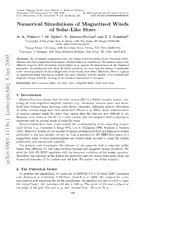
Numerical Simulations of Magnetized Winds of Solar-Like Stars PDF
Preview Numerical Simulations of Magnetized Winds of Solar-Like Stars
Cosmic Magnetic Fields: from Planets, to Starsand Galaxies Proceedings IAU Symposium No. 259, 2009 (cid:13)c 2009International AstronomicalUnion K.G. Strassmeier, A.G. Kosovichev & J.E. Beckman, eds. DOI:00.0000/X000000000000000X Numerical Simulations of Magnetized Winds of Solar-Like Stars A. A. Vidotto1,2, M. Opher2, V. Jatenco-Pereira1 and T. I. Gombosi3 1Universityof S˜ao Paulo, Ruado Mat˜ao 1226, S˜ao Paulo, SP, Brazil, 05508-090 email: [email protected] 2George Mason University,4400 UniversityDrive, Fairfax, VA,USA,22030-4444 3Universityof Michigan, 1517 Space Research Building, Ann Arbor, MI, USA,48109-2143 9 0 Abstract. Weinvestigate magnetized solar-like stellar windsbymeansof self-consistent three- 0 dimensional(3D)magnetohydrodynamics(MHD)numericalsimulations.Weanalyzewindswith 2 different magnetic field intensities and densities as to explore the dependence on the plasma-β parameter.Bysolvingthefullyideal3DMHDequations,weshowthattheplasma-β parameter n a isthecrucialparameterintheconfigurationofthesteady-statewind.Therefore,thereisagroup J of magnetized flows that would present the same terminal velocity despite of its thermal and 8 magnetic energy densities, as long as theplasma-β parameter is thesame. Keywords. stars: coronae, stars: late-type, stars: magnetic fields, stars: mass loss ] R S . h 1. Introduction p Observations have shown that the solar corona (SC) is a highly complex system, con- - o sisting of both long-lived magnetic features (e.g., streamers, coronal holes) and short- r lived ones (coronal mass ejections, solar flares, sunspots). Although indirect detections t s of stellar coronal winds have been performed (Wood et al. 2005), direct measurements a of tenuous coronal winds for other stars rather than the Sun are very difficult to do. [ However, as it occurs in the SC, it is quite certain that the magnetic field is playing an 1 important role in coronalwinds of solar-like stars. v Several studies have been made toward the understanding of an expanding magne- 8 1 tized corona (e.g., Pneuman & Kopp 1971, Low & Tsinganos 1986, Washimi & Shibata 1 1993).However,despiteallthenotableevolutionofbothanalyticalandnumericalstudies 1 performed in the last decades, we are far from a satisfactory 3D MHD description of a . 1 magnetized wind. Severalapproximationsare usually made in order to make the system 0 analytically and numerically tractable. 9 The present work investigates the influence of the magnetic field in solar-like stellar 0 winds with different β’s (the ratio between thermal and magnetic energy densities). We : v solve the fully 3D MHD equations with the temporal evolution of the energy equation. i X Therefore,the topology of the field is not restrictedand the steady-state arises from the dynamical interplay of the outflow and the field. We neglect the stellar rotation. r a 2. The Numerical Model To perform the simulations, we make use of BATS-R-US, a 3D ideal MHD numerical code developed at University of Michigan (Powell et al. 1999). We adopted the same, non-uniformgridresolutionforallthe simulations:the smallestcellsizeis 0.018r0 (near the central body), the maximum cell size is 4.68 r0. The center of the star is placed at the origin of the grid. The axes x, y, and z extend from −75 r0 to 75 r0. 100 Simulations of Magnetized Winds of Solar-Like Stars 101 10 S01 10 S03 10 S05 10 S07 |u|(km/s) |u|(km/s) |u|(km/s) |u|(km/s) 5 5 5 5 z(r)00 22211173096284147703692 z(r)00 433221150271616036396306 z(r)00 765432190888899981368035 z(r)00 433221150271616036396306 -5 -5 -5 -5 -10-7 -3.5 x(0r0) 3.5 7 -10-7 -3.5 x(0r0) 3.5 7 -10-7 -3.5 x(0r0) 3.5 7 -10-7 -3.5 x(0r0) 3.5 7 Figure 1. Meridional cutsof thesteady-state configurations for cases S01 - S07. We consider a star with 1M⊙, r0 = 1R⊙. We initialized the simulations with an isothermal HD wind permeating the grid, and a dipolar magnetic field anchored on the stellarsurface.Thesystemwasthenevolvedintimeuntilsteady-statewasachieved.The inner boundary of the system is consideredto be the base of the wind at r0, where fixed boundary conditions were adopted. The outer boundary has outflow conditions. 3. Results We presenthere four simulations.We considera coronawith temperature anddensity atthebaseofthewindof1.56MKand1.544×10−16gcm−3,respectively.Themagnitude of the magnetic field was varied in each case. For case S01, B0 =1 G; 10 G in S03; and 20 G in S05. In case S07, B0 = 20 G, and density was increased 20 times the previous value. This choice of parameters leads to a plasma-β of: 1 (S01), 0.01 (S03, S07), and 0.0025 (S05). Figure 1 presents meridional cuts of the steady-state configurations: the contours represent the velocity of the flow, black streamlines are the final configuration of the magnetic field, and the white line is the Alfven surface. From Figure 1, we note that the crucial parameter in determining the wind veloc- ity profile is the β-parameter (compare S03 and S07). Therefore, there is a group of magnetized flows that would present the same terminal velocity despite of its thermal and magnetic energy densities, as long as the plasma-β parameter is the same. We also note that the steady-state magnetic field topology for all cases is similar, presenting a configuration of helmet streamer-type, with zones of closed field lines and open field lines coexisting. The wind is not spherical, it is latitude-dependent: higher velocities are achieved at high latitudes. Cases with lower β show more accelerated winds (Fig. 1). The resultant bi-modality of the wind is due to the nature of the magnetic force. A purely HD (non-rotating) wind is spherically symmetric but in the MHD case, this symmetry is lost because the magnetic force has a meridional component. TheauthorsthankFAPESP(04-13846-6,07/58793-5),CAPES(BEX4686/06-3),CNPq (305905/2007-4),NSFCAREER(ATM-0747654),andthestaffatNASAAmesResearch Center for the use of the Columbia supercomputer. References Low, B. C., & Tsinganos, K.1986, ApJ, 302, 163 Pneuman, G. W., & Kopp, R.A. 1971, Sol. Phys., 18, 258, PK71 Powell, K. G. et al. 1999, J. of Comp. Phys., 154, 284 Washimi, H., & Shibata,S. 1993, MNRAS,262, 936 Wood, B. E. et al. 2005, ApJ Letters, 628, L143
